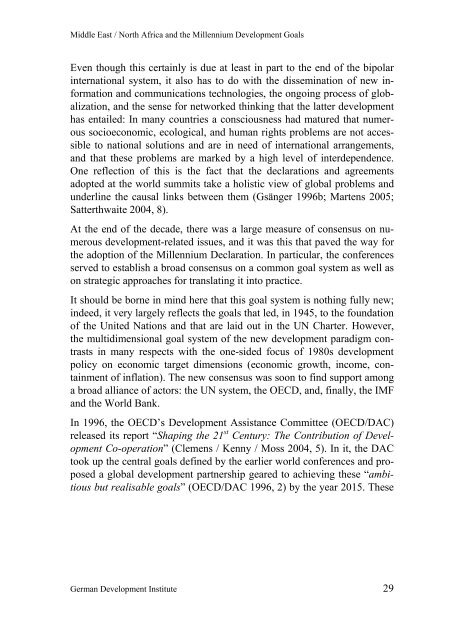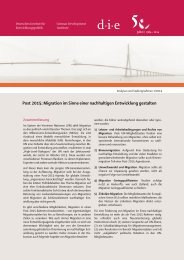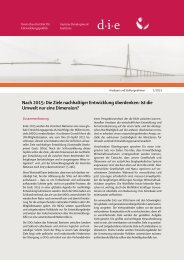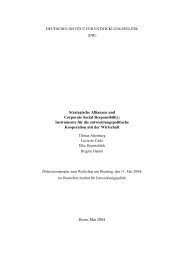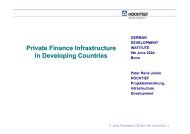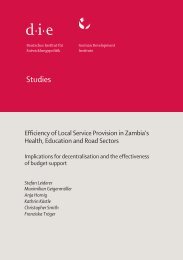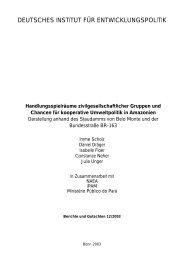Middle East / North Africa and the Millennium Development Goals ...
Middle East / North Africa and the Millennium Development Goals ...
Middle East / North Africa and the Millennium Development Goals ...
Create successful ePaper yourself
Turn your PDF publications into a flip-book with our unique Google optimized e-Paper software.
<strong>Middle</strong> <strong>East</strong> / <strong>North</strong> <strong>Africa</strong> <strong>and</strong> <strong>the</strong> <strong>Millennium</strong> <strong>Development</strong> <strong>Goals</strong><br />
Even though this certainly is due at least in part to <strong>the</strong> end of <strong>the</strong> bipolar<br />
international system, it also has to do with <strong>the</strong> dissemination of new information<br />
<strong>and</strong> communications technologies, <strong>the</strong> ongoing process of globalization,<br />
<strong>and</strong> <strong>the</strong> sense for networked thinking that <strong>the</strong> latter development<br />
has entailed: In many countries a consciousness had matured that numerous<br />
socioeconomic, ecological, <strong>and</strong> human rights problems are not accessible<br />
to national solutions <strong>and</strong> are in need of international arrangements,<br />
<strong>and</strong> that <strong>the</strong>se problems are marked by a high level of interdependence.<br />
One reflection of this is <strong>the</strong> fact that <strong>the</strong> declarations <strong>and</strong> agreements<br />
adopted at <strong>the</strong> world summits take a holistic view of global problems <strong>and</strong><br />
underline <strong>the</strong> causal links between <strong>the</strong>m (Gsänger 1996b; Martens 2005;<br />
Satterthwaite 2004, 8).<br />
At <strong>the</strong> end of <strong>the</strong> decade, <strong>the</strong>re was a large measure of consensus on numerous<br />
development-related issues, <strong>and</strong> it was this that paved <strong>the</strong> way for<br />
<strong>the</strong> adoption of <strong>the</strong> <strong>Millennium</strong> Declaration. In particular, <strong>the</strong> conferences<br />
served to establish a broad consensus on a common goal system as well as<br />
on strategic approaches for translating it into practice.<br />
It should be borne in mind here that this goal system is nothing fully new;<br />
indeed, it very largely reflects <strong>the</strong> goals that led, in 1945, to <strong>the</strong> foundation<br />
of <strong>the</strong> United Nations <strong>and</strong> that are laid out in <strong>the</strong> UN Charter. However,<br />
<strong>the</strong> multidimensional goal system of <strong>the</strong> new development paradigm contrasts<br />
in many respects with <strong>the</strong> one-sided focus of 1980s development<br />
policy on economic target dimensions (economic growth, income, containment<br />
of inflation). The new consensus was soon to find support among<br />
a broad alliance of actors: <strong>the</strong> UN system, <strong>the</strong> OECD, <strong>and</strong>, finally, <strong>the</strong> IMF<br />
<strong>and</strong> <strong>the</strong> World Bank.<br />
In 1996, <strong>the</strong> OECD’s <strong>Development</strong> Assistance Committee (OECD/DAC)<br />
released its report “Shaping <strong>the</strong> 21 st Century: The Contribution of <strong>Development</strong><br />
Co-operation” (Clemens / Kenny / Moss 2004, 5). In it, <strong>the</strong> DAC<br />
took up <strong>the</strong> central goals defined by <strong>the</strong> earlier world conferences <strong>and</strong> proposed<br />
a global development partnership geared to achieving <strong>the</strong>se “ambitious<br />
but realisable goals” (OECD/DAC 1996, 2) by <strong>the</strong> year 2015. These<br />
German <strong>Development</strong> Institute 29


